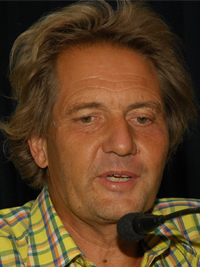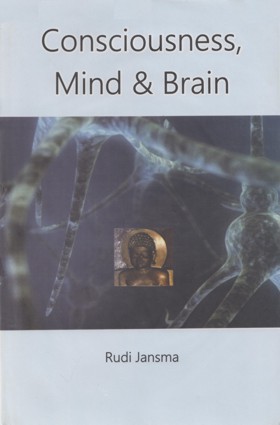Jainism and Buddhism, for example, both teach that after the real separation from the physical body, the deceased human immediate takes on a form of subtle matter according to it character, and that in this body they have sense organs with which they in their death-consciousness can see the things on earth as well as the things of the astral world. In this body they pass at will through physical objects and move instantly to were their thoughts wish them to go. They can see the earthly realm, but (after a while, and generally speaking) may not be very interested in it anymore.
However there are also numerous types of beings who can actively and on their own behalf manifest as helpers and also there are entities with more naughty intentions. Some of them like to be around holy beings and temples and render some service such as protecting the place against evil influences, that means, against other astral living beings. It seems that they can prolong their activities for centuries. Some work miracles like curing people or giving them an undeniable sign of hope. Some appear at special happy or solemn occasions, such as the taking of a religious vow by a serious devotee, and fulfill specific unseen but essential functions, like purifying a place and preparing holy events. The Buddha, in the Dhammapada describes how a man called Magha due to his good life (being good for other people, being charitable, gentle in speech, etc.) after his death was reborn as the head or king (Sakka) of a class of invisible devas.[1] Some classes of devas are grouped in hierarchical functions, from a king down to the humblest servants or executors in the astral realm. The have a direct but unseen perhaps felt by sensitive people influence on earthly affairs, and take care of for example meteorological and geological phenomena.
Kāmarūpas are spooks of personal desires. Some of them can be temporarily woken up to some earthly awareness by the interference of a medium, but actually this is a cruel act on the side of the spiritualists, because the path of the consciousness embodied in the kāmarūpas is upward. Being pulled downward by force they may create karmas of the most horrible types for themselves when being drawn back in the earthly atmosphere, and that will lead them to 'hell' and possibly worse. They have to naturally exhaust their earthly desires before awakening in a much higher sphere (far beyond the so-called Summerland[2] of spiritualism). The act of necromancy (communication with the dead) has been practiced by shamans of virtually all cultures, but is generally despised by truly spiritually oriented people. Not only is this practice cruel to the consciousness of the deceased, it also reaches only the lowest and often vilest parts of worlds of the deceased. Nevertheless, when not drawn down by the séancists' selfish intentions and desires, in some cases kāmarūpas can help to acquire indications for healing purposes and information that is only available on the astral plane, as has been amply demonstrated by the famous and rare American sensitive Edgar Cayce[3], and in varying degree by many other mediumistic persons.
Tibetan View
For the outsiders at the bedside, the body begins to become cold and the various functions fall away. The body itself is thought of as composed of the elements: the etheric, fire, air, water and earth, i.e. body warmth, the respiratory system, the fluid systems and the hard structure. The bystander perceives the cooling, drying, irregularity and than stoppage of breath and hardening of the tissues. The elements withdraw one by one, and the senses belonging to the elements, i.e. hearing, seeing, smelling, tasting and tactile perception are lost. For the dying person it is like falling asleep. The ability to experience physical pain is disappearing in the first stages. His physical seeing and other perceptions which until that moment still worked even though outsiders did not notice it fail one by one, just when one falls asleep. This is the process of the withdrawal of the prāṇas through the nāḍīs the 72,000 energy channels. The prāṇas withdraw from the extremities first, then from the limbs and the other parts of the body. They accumulate in the central channel along the spine the lower part if the spine as well as the higher part. Then they unite in the region of the heart. For all external observations. The person is now dead. Still, the 'snapping of the cord' i.e. the final departure of prāṇa through one of the openings of the body, is the real moment of dying. The best 'opening' to leave the body is the fontanel in the top of the skull and this naturally happens with people who have led a spiritually oriented life.
Tibetans talk in detail about the dissolution of the elements of which the body exists unawares for the dying person and at the same time the inner experiences the dying person goes through.
When the moment of dying comes, either in mindful and peaceful death, at the end of a coma or in 'common people's' dying, natural processes take over from those chosen by the mind. Of the stages of dying as well as the experience of the consciousness of the dying person she or he cannot communicate to the people around. The vitalities gather in the central channel near the back bone, and with them dissolve the elements (solid: bone: fluid: blood etc.; airy: breath; fiery: body warmth, etc.) and the awareness of sense impression related to these elements withdraws quietly and one by one, without effort, without pain. In the meantime, consciousness goes through a succession of phases of increasing clarity.
While all the physical elements dissolve, the conceptions or mentalities belonging to the mind during life on earth also dissolve. This is said to take place in three phases, and that the consciousness experiences three subsequent stages of increasing clarity. In the book Death Intermediate State and Rebirth by Lati Rinbochay[4] 80 mentalities or conceptions are mentioned, some great, some middle and some small. A few examples: a mind going to external objects; mental pain of separation; (mental) peace; fear; attachment; hunger; thirst; mundane compassion; shame; mercy; excitement; flirtation; untruth; heroism; crookedness; depression; doubt, altogether eighty in all divided over three categories. You see that it includes mental properties which we regard as positive but even these are no more than mental reflections. True compassion, mercy, etc. are qualities of the soul which never dies. All these mentalities dissolve just as the physical properties and sense perceptions have dissolved. What remains is a consciousness 'as clear as the autumn sky' (after the great rains). The third and last phase is called 'near attainment' because it approaches the 'clear light'.
The whole processes of dying it is a period of increasing calm and clarity of mind, compared to a unpolluted clear sky in moonlight or dawn or moonless midnight. Before the clear light of death the latest moments which can in some cases last some 3½ days or even more the states of awareness become so subtle that average people just lose consciousness, i.e. they can not perceive anything consciously on these levels. When speaking of 'losing consciousness' this is not the same as the losing of the consciousness at the end of a near-death experience. The consciousness in the clear lights would be too subtle to be experienced by the waking mind. But even then a stage may be reached where a still more spiritual layer of inner perception is needed to remain awake some subtlety of perception that has not been developed in average people.
Great yogis, as said above, can use this period to stay awake and perform the highest and subtlest meditations, and eventually choose to return to the sphere of the Earth out of compassion as a nirmāṇakāya or remain elsewhere in other non-physical bodies. But common people will faint before the manifestation of this 'clear light of death' and only come to senses in their astral body. The experiences which were partly impressed by the physical brain into the experience, are no more.
It is in the time before the fainting, when the physical brain, or at least its astral model (liṅga) has not yet decayed, the dying person sees the vision known as a review of one's past life. Saved or resuscitated people often say that their entire life passes before their eyes in minute details. Not only the facts of it, but also the meaning, the intentions, motivations and purity of motive as seen in the light of their 'higher self'. One becomes aware of what one has done 'wrong' in life, and also of the reason and karmic or universal justice of the bad or 'unjust' experiences one had in life.
After true (first) death, the experiences which were partly impressed by the physical brain into the experience of the dying person, are no more. The astral body in which they awaken is spontaneously created by the automatic influence of the mind attracting and arranging the astral atoms belonging to that level. There are, of course, many levels of subtlety in astral matter. Nothing physical remains. They are back in reality as it were though the properties of astral matter differ considerably from those of physical matter. It will still require very much scientific investigation to gain understanding of the laws of the astral universe. I don't think quantum physics will be of much help. It would need systematic recording of paranormal experiences, study of occult philosophy and forming consistent theories based on refined distinction of the great variety of properties and levels of the astral light, unbiased by the vast scientific knowledge and theorizing of the physical plane.
A term used by Spiritists for what they hold to be the abode of departed spirits, but what it really is not. It actually is a more beautiful type of illusion projected in the lower astral regions, and the kāmarūpas abiding there will decompose before the second death
Edgar Cayce (1877 1945) was an American medium who answered questions on subjects as varied as healing with astounding successes regarding medicine and knowledge of personal reincarnations, wars, Atlantis, and future events while in a trance
 Dr. Rudi Jansma
Dr. Rudi Jansma
